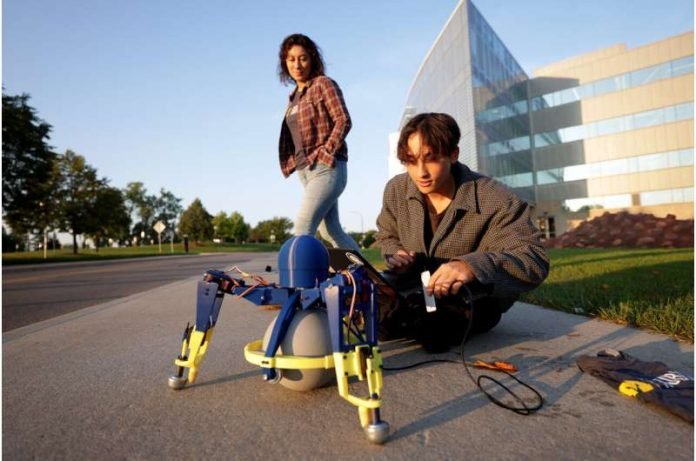
Researchers at the University of Michigan have created an innovative robot named SKOOTR that’s changing the game in robotics.
Unlike the traditional robots we’re used to, SKOOTR has three legs and a unique ability to move around without toppling over. This design makes it much more stable than its three-legged counterparts, which often struggle with balance due to missing a fourth leg.
The brains behind SKOOTR, Talia Y. Moore and her team, were inspired by the natural world.
Moore, who focuses on creating open-source robots that often mimic biological movements, found her inspiration in an everyday office chair.
She noticed how effortlessly she could glide across the room, using her legs to maneuver in any direction without losing balance. This, she realized, mirrored the way brittle stars move in water.
With this insight, Moore aimed to combine the adaptability of a rolling object with the stability of a creature with legs. The vision was a robot that could effortlessly change direction thanks to a design inspired by sea stars and spider webs.
This would require a brand-new approach to movement, blending rolling and pushing actions. Adam Hung, an undergraduate student, took on the challenge, building SKOOTR with a 3D printer at home over the summer.
SKOOTR stands out with its central sphere, supported by three robotic legs. This design allows for a variety of movements and adaptations.
Each leg is equipped with joints for movement and a hybrid tip that can either grip the ground for traction or roll to maintain position.
The sphere itself is interchangeable, making SKOOTR highly customizable for different tasks, from carrying objects to overcoming obstacles like stairs.
What sets SKOOTR apart is its remarkable stability. According to Moore, it’s virtually impossible to flip SKOOTR over when it’s moving. This stability, combined with its ability to navigate obstacles, makes SKOOTR a standout in the field of robotics.
The team is excited about SKOOTR’s future possibilities.
They plan to explore the advantages of radial symmetry in robots, uncover new ways of moving, and develop more open-source robots that can aid in various research fields, including neuroscience, where SKOOTR’s unique movements could offer insights into the movement patterns of octopuses.
SKOOTR is not just a step forward in robotics; it’s a leap towards understanding and integrating the fluidity and versatility of natural movements into the mechanical world.
With its innovative design and potential for customization, SKOOTR is poised to make significant contributions to robotics, science, and our understanding of the natural world.
The research findings can be found in arXiv.
Copyright © 2024 Knowridge Science Report. All rights reserved.



